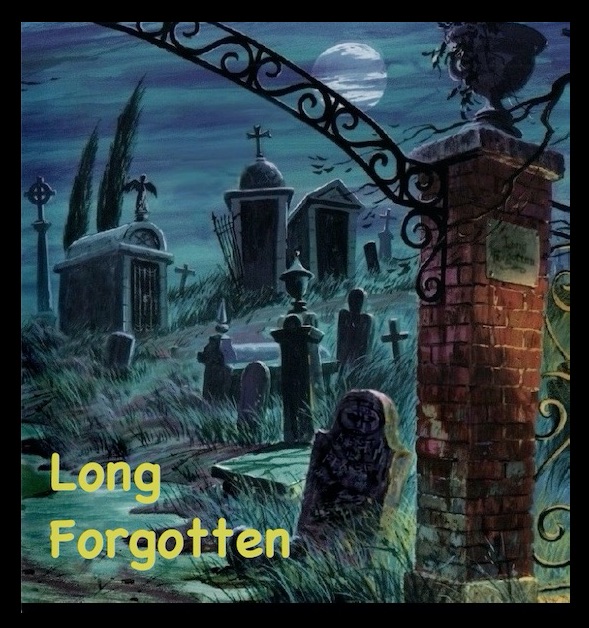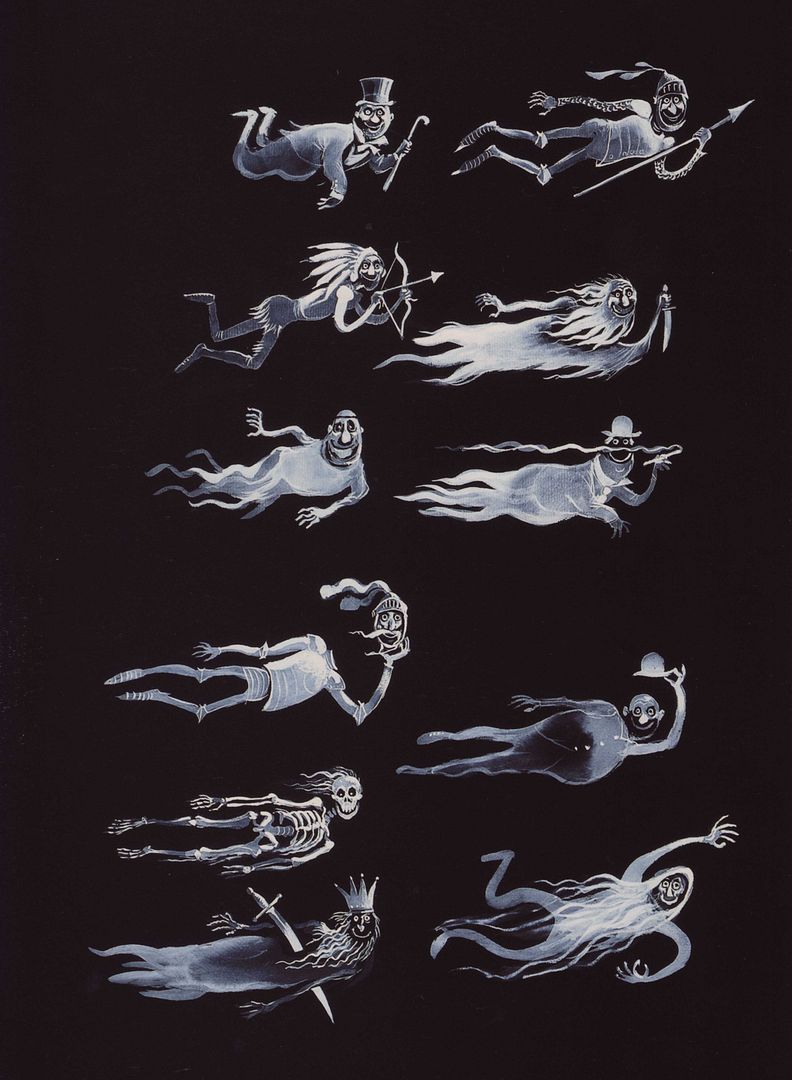Info from newly rediscovered documents confirms much of what
follows and adds details (in red). Major update, October 2019 (in green).
You know the drill. As the show winds down, you go past a set of mirrors, and in the mirrors you see one of the hitchhiking ghosts sitting beside you. But it was not always so, says I. If you rode the HM during its opening week, you would have seen something else in those mirrors.
This was the original "Long-Forgotten Haunted Mansion effect," and it remains one of the most intriguing.
I rode the HM on Thursday, August 14th, 1969 (I was 14). There's a lovely story about how I got to ride during opening week, but that's for another time. There has also been a mighty tempest over when exactly the HM first opened, but that's another post as well.
Going past the mirrors, what I remember seeing is clouds of faceless, wispy spirits surrounding and mobbing the doombuggy. They were undulating and following along with you as you scooted past. Very cool. But on my next visit, no more than a few weeks later, the wraiths were gone, and I was startled to see the familiar effect that we have there now. "Hey, that's different!" was my reaction.
Flash forward 35 years, and the Internet has provided a means for HM fans to discover and communicate with each other. I dipped my toes into Doombuggies.com at my brother's suggestion, and—what a cool site. Mansionology has been a secret vice ever since. Well anyway, here was my chance, I figured. Surely someone else remembers this effect, right? Wrong. I dropped an email to "Chef Mayhem" at Doombuggies.com and to Chris Foxx at the now-defunct grimghosts.com. Here's what I wrote to the Chef on Aug 4, 2002:
And the similar email to Chris six days later:
No luck. Neither had ever heard of my wraiths. Well, let's throw the question open, shall we? I started a thread on the DB.com chatboards and described the effect yet again:
"One of the things I remember from my first ride on the HM, opening week 8/69, was that the HHGs did not reappear in the mirrors. Yeah, they were standing there as always as you entered the crypt, but that was it. Instead, in the mirrors there were wispy ghosts much like the graveyard wraiths surrounding the buggy as you moved along." (I still have copies of the relevant sections of that discussion thread.)
All of this tedious stuff is necessary to show that I was making these wild claims well before...
THE... the... the BLUE... lu... lu... lu PRINT... int... int... int
...came to my attention. One of the participants in that chatboard discussion mentioned a HM effects blueprint in his possession with some curious items on it. He graciously sent me a copy. Eventually I was able to get a much cleaner copy of the same b-print (thanks to Datameister at Micechat).
The HHG-in-mirror effect is produced by a set of 15 rod puppets on an oval track behind two-way mirrors. The room is oddly shaped, being custom built for the ghosty-go-round. Here's an old b-print that shows the set-up as it is today:
You can see the oval track and how it fits the room. But on the effects blueprint I got from the poster at DB.com, there is no track; instead, there are three projectors focused on a wavy screen marked
CURVED BACK PROJ. SCR'N :
Whoa. This b-print is dated 4-8-69. The original date on the other b-print is illegible, but it was updated on Feb 7, '69, and its last update was 4-7-69,
the day before the other b-print was produced. Thus, our projector system is on a b-print that was the direct successor to one which shows the effect as it is seen today. Even without this info, it is plain that the ghosty-go-round was always what was planned, since the room itself is obviously shaped around it. In contrast, the projector system obviously does
not fit the room very well. Look at all the wasted space. So, what gives? Why does the effects b-print which is actually
closer to opening day have this funky substitute?
Another source of info about the HM as it was in the beginning is newspaper reports and reviews of the new ride. Pre-opening publicity stories that mentioned the HHGs began to appear in the Spring of '69:
"Ghostly hitchhikers trying to jump aboard" sounds like the effect as it is seen today. There was a press preview of the ride at midnight, August 11, with the 12th slated as the official opening day. A few reviews of the newly-opened HM appeared in the papers as early as Tuesday the 12th, but most were published Wednesday the 13th. Among all of these, a handful make passing reference to the HHG-in-mirror effect. Tony Lawrence in the Hollywood Reporter, Aug 13, gives a rather ambiguous description that could fit either effect:
In a review published a day earlier (the 12th), Sandi Mosley in the
Orange County Register describes what sounds like our current effect:
If this was all we had, we could reasonably conclude that whatever that b-print showed, the Gus-Ezra-Phineas roulette we all know and love was there by opening day. But there is another review that sounds altogether different. This is from Keith Murray's review in the Pasadena Star-Times, published on the 13th:

What is this "peering into the fog" business? And why does he apparently see only himself in the doombuggy? Hmm. The wraiths I remember did indeed look like a swirling cloud of spirits. Now the evidence is getting murky again. How do we reconcile Mosley and Murray? Assuming they are both providing good faith, reasonably accurate accounts of what they saw, there is only one way to do it that I can see. Mosley is explicit that she rode the HM at the midnight press preview Aug 11/12. Her review appears on the 12th. Murray nowhere claims to have been at that preview, and his review appears on the 13th. It is possible that he rode sometime during the day of the 12th and wrote his review for publication the next day. Mosley's and Murray's rides could have been 12 hours apart, or even more. Was the ghosty-go-round there for the midnight showing and then hastily replaced by our projected wraiths? That would explain it, but is there any warrant for such a scenario?
Of course there is, or I wouldn't be wasting your time (or mine). Something must account for the alternate set-up behind the mirrors, after all. What we now know from newly discovered material evidence is that the projected wraiths were simply the backup for the HHG ghosty-go-round. It probably could have been set up in a matter of hours. Look, it's not complicated. Here are the two side-by-side:

Okay, now let's superimpose them:
See? The wavy screen sits right in front of the HHG track, about where the low curtain stands in this photo:
Edit: In 2014 this 1969 schematic came to light, showing both of the effects superimposed, exactly like above.
[ EDIT 4-30-2022] And here's a surprise. At one point they had the same back-up planned for the WDW Mansion, in case they needed it.
And why would they need this backup? Because if the ghosty-go-round goes down, they will douse the lights on the motionless hitchhikers, and now you've got the guests riding past mirrors looking at themselves and nothing else. That's intolerably dumb. You have to put something there. You need a backup effect if the planned one fails.
Did they anticipate such a failure? You bet they did, that's what the blueprint is all about. In addition, there is the intriguing comment made by show author X Atencio in Storyboard magazine. Speaking of the HHGs, X said: "It was kind of an afterthought, though. It didn't come until the ride was practically put in there." Based on this, both Surrell's Haunted Mansion book and Doombuggies.com [in earlier iterations, but not since 2019] claim that the HHGs were a last-minute addition to the ride.
Bull crap. The problem with X's remark is that what it says is literally impossible. The show building went up in early 1969, and the HHG-in-mirror gag is plainly visible in 1968 blueprints.
The idea itself is much older, going back to Ken Anderson's plans for a DL haunted house in 1957-58. Guests walk down a hall with mirrors on each side showing ghosts accompanying them. Traveling ghosts looping around a central barrier that hides their return, coupled with clever use of two-way mirrors—yep, it's all there.

The best explanation for X's flub is that the originally-planned HHG effect—the one that is there today—did not look like it was going to be ready by opening day, so a temporary effect was worked out and constructed, something to have in the mirrors until whatever demons were ailing the Gus-Ezra-Phineas show were exorcised.
(We now know that this backup effect was built in the middle of April.) But the Imagineers wanted to show the press what the permanent effect was going to look like once it was up and running, so they managed to get the ghosty-go-round working for the midnight showing, and then they immediately went back to their backup. I suppose that X's memory of this frantic mess was a little hazy, and that's why he spoke misleadingly to
Storyboard. They were using the backup effect on Thursday when this geeky teen rode.
Over the years I've met several others who remember the misty ghosts, and I'm told they were in use off and on for months. In 2019, Imagineer and Disney historian Tom Morris convincingly identified the ghostie-go-round problem that made the backup system necessary: they had difficulty keeping the ghosts and the doombuggies synchronized. This problem actually continued for years before they finally solved it for good. Up until then you sometimes saw the ghosts appearing off to one side, or even between the buggies, and some people still remember this irritating defect. For the midnight press event, the Imagineers figured they could trust the ghosts and buggies to remain synchronized for at least a few hours, so they decided to show the intended, permanent effect to the press and then went back to the backup as soon as the presentation was over.
How did the backup effect work? If I may speculate, it was yet another example of Yale Gracey genius at work. The projectors were the same as the ones Yale invented for use in the Blue Bayou lagoon (the clouds moving on the "sky") and used again in the HM for the misty clouds moving along the wall in the Limbo loading area and on the scrims in the graveyard.
The wavy, curved screen was 40 feet long and 12 feet wide. It was back-projected with these moving ghosts. The curves made them undulate and gave them animation. They were bright enough to be seen in the mirrors against the dark outside of your doombuggy, but were washed out and therefore invisible against the much brighter interior where you sit.
This delicate balance was achieved by adding new lights, both in front of the buggies (spotlights) and behind them (new fluorescent lighting). Blueprints show that these were installed at the same time that the backup effect was constructed, as part of the same project. Thus, the ghosts looked like they were surrounding and mobbing you, but they were not inside the doombuggy with you.
There's a photoshop recreation of the effect
HERE.
Whew. All that for that.




























